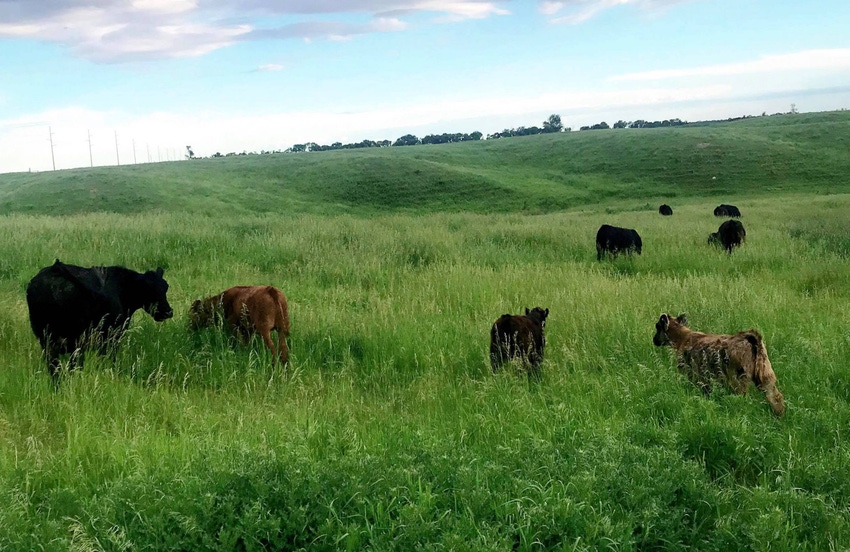Check out recent headlines on current agricultural land trends.
July 31, 2019

Last weekend, my husband Tyler and I made a cattle run down to Oklahoma, and on our way we stopped to visit the Pioneer Woman Mercantile.
In case you missed my recap, you can check it out here.
On our route, we drove through South Dakota, Nebraska, Kansas and Oklahoma. We saw rows and rows of corn fields, acres of hay fields and quiet rural communities featuring main street mom and pop businesses.
As we passed through cattle country, I was impressed by the vast rolling prairie that stretched to the horizon. Far from the hustle and bustle of urban cities, I felt at peace in a place where cattle were grazing as far as the eyes could see.
To me, as we traveled through the heartland of America, this is home. These are the foundation states, where food is grown and energy is derived. This is where our national security begins and ends, because after all, if our people were ever unable to have enough food, to keep their houses heated and the lights turned on or to have clothes on their backs, it would lead to famine, war, depression, homelessness and vulnerability as a nation.
So yes, these foundation states are incredibly important, and that’s why it’s troubling to see so much farm and ranch land be converted to concrete jungles as a result of urban sprawl and community development.
However, that’s par for the course. Supply and demand of farmland would dictate that the highest bidder wins the acres, and sometimes the owner is in the hands of the producer, and other times, it’s the developer who has the funds to purchase the land.
With commodity prices in the tank, market uncertainties continuing due to trade war disputes, increasing input costs and debt loads and more young people abandoning rural America in pursuit of more secure career opportunities, I believe we will see a lot of land exchange hands in the next couple of years.
So that begs the question, is now the time to buy farmland? I don’t think we have seen the low yet as far as land prices go; however, I also think there are enough buyers out there for the available supply of acres to keep prices pretty competitive.
But don’t take my word for it. I’m not a farmland realtor. Instead, check out these recent headlines to gather more information on agricultural land trends and see for yourself if now is the time to buy or to put your acres on the market.
1. “Farmland loss is a national crisis, and felt mightily in the West” by Hannah Clark, American Farmland Trust (AFT)
Clark writes, “Between 1992 and 2012, 31 million acres of farmland and ranchland disappeared according to research from our recently released ‘Farms Under Threat’ analysis — the most comprehensive study ever on agricultural land loss in the U.S.
“While 31 million acres may not sound like a lot, at AFT, it set off alarm bells. It represents as much agricultural land as is in the state of Iowa. And, perhaps more importantly, 11 million of those acres were our best and most productive agricultural land — land most suitable for intensive food production with the fewest environmental impacts.”
2. “Western farmland continues to disappear” by Brad Carlson for the Capital Press
Carlson writes, “Without the tools that a succession plan might utilize, large portions of the nation’s agricultural land base are vulnerable to fragmentation, conversion to non-agricultural uses, and transfer of ownership to non-farmers.”
3. “Calls picking up despite continued uncertainties in 2019” by Randy Dickhut, Farmers National Company
Dickhut writes, “The calls from landowners thinking about selling their land during the upcoming months are picking up. This is despite the uncertainties in ag this season and shows that landowners are looking for good advice during what is another chapter in a string of challenging years for agriculture. Landowners wanting to sell are thinking ahead to terminating leases and not negotiating rents for 2020. Lease negotiations for 2020 will be difficult with an expected late harvest season, grain price gyrations, and crop yields that will be quite variable by area. Sellers also have target time frames for when they want to close on the sale, so planning has to begin well in advance in order to properly list, market, and sell the property.”
4. “Farmland ownership and tenure” by USDA’s Economic Research Service
According to the USDA’s Economic Research Service, “Trends and patterns in the ownership of agricultural land are of perennial interest to all involved with the farm sector. Farmland tenure, which broadly refers to the institutions governing the control and use of farmland, shapes many farm decisions, including those related to production, conservation, and succession planning. Given the relatively advanced age of many farmers, both tenure and ownership can also have important implications for access to land, an issue that is particularly salient for new and beginning farmers. A majority of U.S. land in farms is owner-operated—over 60%. The national share of farmland that is owner-operated has been relatively stable over the past 50 years, with a noticeable decline during the farm crisis of the 1980s.”
The opinions of Amanda Radke are not necessarily those of beefmagazine.com or Farm Progress.
About the Author(s)
You May Also Like





